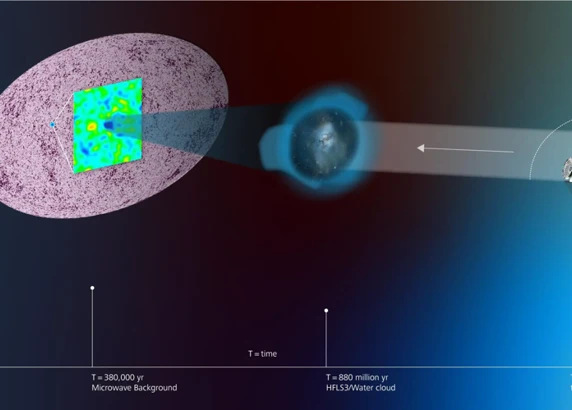The cosmic microwave background (CMB) has captivated scientists and astronomers alike since its accidental discovery in the 1960s, revolutionizing our understanding of the early universe. This enigmatic radiation permeates the entire cosmos and carries important clues about the origins and evolution of the universe. In this article, we will delve into the fascinating world of the CMB, exploring its discovery, properties, and its profound connection to the Big Bang theory. Join us on this cosmic journey as we unravel the mysteries hidden within the faint echoes of the universe’s infancy. Prepare to be astounded and captivated by the wonders that the CMB has in store for us.
Contents
- What is the Cosmic Microwave Background (CMB)?
- The Big Bang Theory and CMB
- Mapping the CMB
- Cosmic Inflation and CMB
- Connecting with the Early Universe
- Future Prospects
- Conclusion
-
Frequently Asked Questions
- 1. How was the Cosmic Microwave Background (CMB) discovered?
- 2. What are the properties of the Cosmic Microwave Background?
- 3. How does the Cosmic Microwave Background support the Big Bang theory?
- 4. What is the significance of mapping the Cosmic Microwave Background?
- 5. Which satellites have been instrumental in mapping and studying the CMB?
- 6. What is Cosmic Inflation?
- 7. How does the Cosmic Microwave Background provide evidence for Cosmic Inflation?
- 8. What information does the Cosmic Microwave Background reveal about the early universe?
- 9. How does studying the Cosmic Microwave Background help in understanding dark matter and dark energy?
- 10. What does the future hold for Cosmic Microwave Background research?
- References
-
Frequently Asked Questions
- 1. How was the Cosmic Microwave Background (CMB) discovered?
- 2. What are the properties of the Cosmic Microwave Background?
- 3. What is the Big Bang Theory?
- 4. How does the Cosmic Microwave Background relate to the Big Bang Theory?
- 5. How was the CMB mapped?
- 6. What is cosmic inflation?
- 7. How does the CMB provide evidence for cosmic inflation?
- 8. What information does the CMB provide about the early universe?
- 9. How does the CMB help in studying dark matter and dark energy?
- 10. What are the future prospects in CMB research?
- References
- Read More
What is the Cosmic Microwave Background (CMB)?
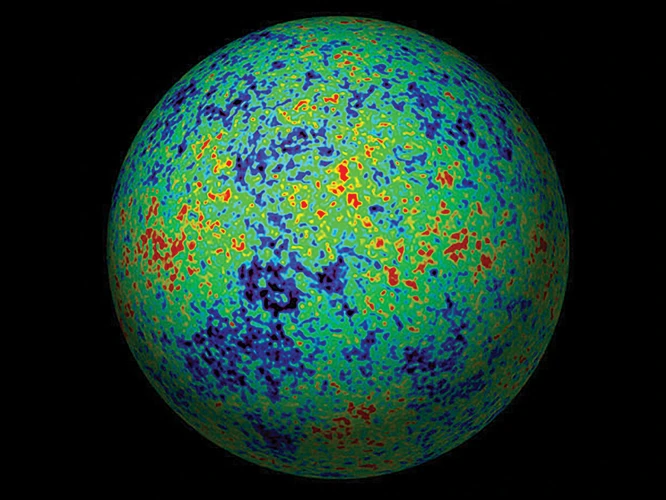
The Cosmic Microwave Background (CMB) is a faint radiation that permeates the entire universe, serving as a relic of the early stages of our cosmos. Discovered accidentally in the 1960s by Arno Penzias and Robert Wilson, who were investigating radio signals, this cosmic radiation has since become a crucial window into the universe’s earliest moments. The CMB consists of radio waves that have been stretched and cooled over billions of years, and it appears as a uniform glow from all directions in the sky. This remarkable discovery has provided scientists with valuable information about the age, composition, and geometry of the universe. It has played a pivotal role in confirming the Big Bang theory and our understanding of the universe’s evolution. The CMB has opened up a new realm of exploration and continues to shed light on the mysteries of our cosmic origins.
1. Discovery of CMB
The discovery of the Cosmic Microwave Background (CMB) came about through a series of serendipitous events. In the 1960s, Arno Penzias and Robert Wilson were conducting experiments using a large horn antenna at Bell Labs in New Jersey. They were attempting to measure radio waves bouncing off Echo balloon satellites, but they encountered an unexpected signal that seemed to come from every direction in the sky. Initially, they believed the signal was due to interference from pigeon droppings inside their antenna, but after removing the droppings and cleaning the equipment, the signal persisted. They soon realized that this persistent noise was not from Earth or our galaxy, but rather a faint radiation coming from space itself. This accidental discovery, later recognized as the CMB, earned Penzias and Wilson the 1978 Nobel Prize in Physics. The detection of the CMB marked a groundbreaking moment in astrophysics, providing compelling evidence for the Big Bang theory and opening up a new era of cosmological research.
2. Properties of CMB
The properties of the Cosmic Microwave Background (CMB) are vital in understanding the nature of this cosmic radiation. First and foremost, the CMB is incredibly uniform and isotropic, meaning that it appears the same from all directions in the sky. Its temperature is remarkably uniform as well, with only slight fluctuations at a minuscule level. These fluctuations, often referred to as anisotropies, provide valuable information about the composition and structure of the early universe. Another important property of the CMB is its blackbody spectrum, which closely follows the Planck curve. This spectrum reveals the radiation’s thermal nature and allows scientists to calculate its temperature, providing further evidence for the Big Bang theory. Additionally, the CMB exhibits a slight polarization, providing insights into the early universe’s magnetic fields and gravitational waves. Studying these properties of the CMB helps us understand the universe’s evolution, its composition, and the physics governing its early stages.
The Big Bang Theory and CMB

The Big Bang theory, one of the prevailing cosmological models, proposes that the universe originated from an incredibly dense and hot state around 13.8 billion years ago. The discovery of the Cosmic Microwave Background (CMB) has provided strong evidence in support of the Big Bang theory. Studies of the CMB have revealed that it is a uniform and isotropic radiation that fills the entire observable universe. Its temperature is measured to be approximately 2.7 Kelvin, corresponding to microwave wavelengths. This remarkable consistency in the CMB’s properties supports the idea that it is a remnant of the intense thermal radiation that characterized the early universe. The CMB has not only bolstered the credibility of the Big Bang theory but has also allowed scientists to probe deeper into the nature of the early universe and its subsequent evolution. Its discovery truly marked a significant turning point in our understanding of the cosmos and our place within it.
1. The Big Bang Theory
The Big Bang Theory is the prevailing scientific explanation for the origin and evolution of the universe. It suggests that the universe began as a singularity, a point of infinite density and temperature. Approximately 13.8 billion years ago, a rapid and explosive expansion known as the Big Bang occurred, unleashing an enormous amount of energy and setting the universe in motion. This theory is supported by a wealth of observational evidence, including the redshift of distant galaxies, the abundance of light elements, and the detection of the cosmic microwave background (CMB). The CMB, being one of the strongest pieces of evidence for the Big Bang, provides valuable insight into the early phases of the universe by revealing its temperature and uniformity. It shows that the universe was once extremely hot and dense, and has been expanding and cooling ever since. The Big Bang Theory is a cornerstone of modern cosmology and sets the stage for further exploration into the cosmic mysteries that lie beyond our reach.
2. Relationship between CMB and the Big Bang Theory
The relationship between the cosmic microwave background (CMB) and the Big Bang theory is one of profound significance in our understanding of the universe’s origins. According to the Big Bang theory, the universe began as an incredibly hot and dense singularity that expanded rapidly, giving rise to everything we see today. As the universe expanded, it also cooled down, allowing elementary particles to combine and form atoms. However, in its early stages, the universe was too hot and dense for light to travel freely. This opacity prevented light from escaping, creating a “cosmic fog” that obscured our view of the early universe.
The pivotal moment came around 380,000 years after the Big Bang, when the universe had cooled down enough for protons and electrons to combine and form neutral hydrogen atoms. This event, known as recombination, marked a turning point for light. Photons were finally able to travel freely through space without scattering off particles. These photons have been traveling through space ever since and make up the cosmic microwave background we detect today.
The CMB serves as powerful evidence for the Big Bang theory because it provides a snapshot of the universe when it was just 380,000 years old. By studying the patterns and fluctuations in the CMB, scientists can gain insights into the conditions and properties of the early universe. The uniformity and isotropy of the CMB align with the predictions of the Big Bang theory, validating its fundamental principles.
Additionally, the CMB provides crucial information about the composition and evolution of the universe. By analyzing the intensity and temperature fluctuations in the CMB, scientists can determine key parameters, such as the density of matter and the presence of dark energy. Through precise measurements of the CMB, we have discovered that the universe is primarily composed of dark matter and dark energy, which play significant roles in its expansion and structure formation.
The relationship between the CMB and the Big Bang theory is a symbiotic one. The CMB provides concrete evidence for the Big Bang and offers a unique window into the early universe. By studying the CMB, scientists continue to deepen our knowledge of the cosmos and unravel the mysteries of its origins.
Link to relevant anchor: dynamic-duo-gemini-aquarius-compatibility
Mapping the CMB
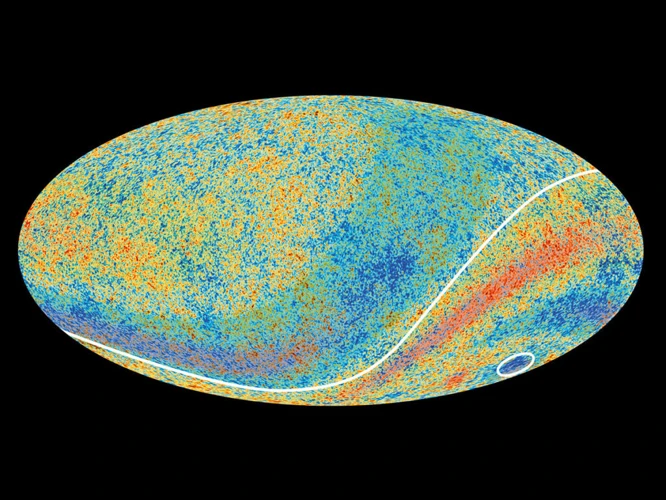
Mapping the CMB has been instrumental in unraveling the secrets of the early universe. Scientists have utilized several groundbreaking missions and satellite observations to chart the cosmic microwave background in exquisite detail. One such mission was the Cosmic Background Explorer (COBE) satellite, which launched in 1989 and provided the first full-sky map of the CMB’s temperature fluctuations. This ground-breaking mission confirmed the cosmic microwave background’s isotropy and laid the foundation for further exploration. Building upon COBE’s success, the Wilkinson Microwave Anisotropy Probe (WMAP) mission launched in 2001, capturing even more precise measurements of the CMB. The data from WMAP not only verified the Big Bang theory but also shed light on the age, composition, and expansion rate of the universe. The most recent endeavor in CMB mapping is the Planck satellite, which was launched in 2009. Equipped with advanced instruments, Planck has provided the most accurate and detailed maps of the CMB to date, enabling scientists to study the early universe with unprecedented precision. These mapping missions have revolutionized our understanding of the cosmic microwave background, giving us valuable insights into the origins and evolution of our vast universe’s cosmic fabric.
1. COBE Satellite
The COBE satellite (Cosmic Background Explorer) played a pivotal role in studying the cosmic microwave background (CMB) and revolutionizing our understanding of the early universe. Launched by NASA in 1989, COBE was equipped with three key instruments: the Differential Microwave Radiometers (DMR), the Far Infrared Absolute Spectrophotometer (FIRAS), and the Diffuse Infrared Background Experiment (DIRBE). The DMR measured the temperature fluctuations in the CMB with unprecedented accuracy, providing crucial evidence for the Big Bang theory and confirming its predictions. FIRAS, on the other hand, measured the spectrum of the CMB, confirming that its radiation followed a perfect black body curve. DIRBE focused on mapping the infrared background over the entire sky, offering valuable insights into the distribution of dust and other matter in the universe. The data obtained by the COBE satellite transformed our understanding of the CMB, earning John Mather and George Smoot the Nobel Prize in Physics in 2006. Thanks to its contributions, scientists gained a deeper understanding of the universe’s early moments and established the foundation for future missions to explore and unlock further mysteries.
2. WMAP Mission
The WMAP (Wilkinson Microwave Anisotropy Probe) mission, launched by NASA in 2001, played a pivotal role in mapping the cosmic microwave background (CMB) with unmatched precision. It operated until 2010 and provided scientists with invaluable data for studying the early universe. The WMAP satellite was equipped with cutting-edge instruments that measured the temperature fluctuations in the CMB across the entire sky. These fluctuations provided crucial insights into the distribution of matter and energy in the early universe. The mission’s data helped to refine the age of the universe, determining it to be approximately 13.77 billion years old with a 1% uncertainty. Additionally, WMAP’s observations confirmed the existence of dark matter and dark energy, two mysterious components that make up the majority of the universe. The mission’s findings provided a solid foundation for further cosmological research, and its precise measurements continue to shape our understanding of the universe’s origins and evolution. The WMAP mission was a remarkable achievement, paving the way for subsequent missions, such as the Planck satellite, to delve even deeper into the secrets of the cosmic microwave background.
3. Planck Satellite
The Planck Satellite, launched by the European Space Agency (ESA) in 2009, revolutionized our understanding of the cosmic microwave background (CMB). Its mission was to create a highly precise map of the CMB, capturing minute temperature fluctuations across the sky. By measuring these fluctuations, the Planck Satellite provided valuable insights into the early universe, helping to refine our understanding of the Big Bang theory and the formation of cosmic structures. With its advanced instruments, including the High-Frequency Instrument (HFI) and Low-Frequency Instrument (LFI), Planck detected temperature variations in the CMB with unparalleled accuracy. It also measured the polarization of the CMB, which carries additional information about the universe’s early conditions and its subsequent evolution. The data collected by the Planck Satellite enabled scientists to study the distribution of matter and energy, the abundance of dark matter and dark energy, and the overall structure of the universe. The mission’s significant findings include confirming the age of the universe (approximately 13.8 billion years old) and providing insights into the composition of the cosmos. The Planck Satellite has truly been instrumental in advancing our knowledge about the CMB and deepening our understanding of the early universe. With its groundbreaking discoveries, it has paved the way for future missions and continued exploration of the cosmic microwave background.
Cosmic Inflation and CMB
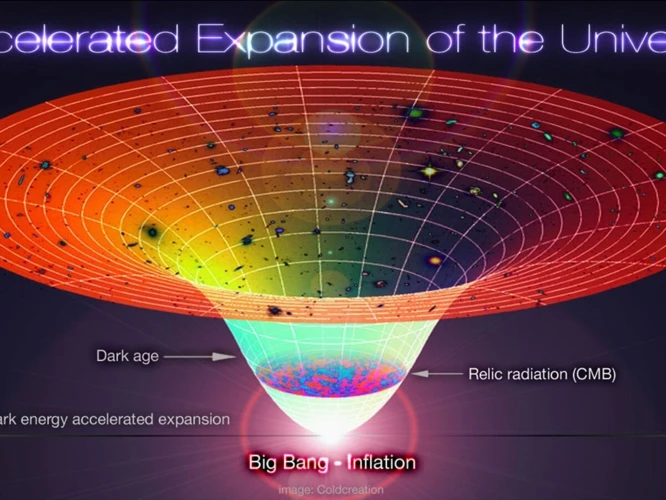
Cosmic inflation refers to a brief period of exponential expansion in the early universe, just moments after the Big Bang. This concept was proposed as an explanation for the remarkable uniformity observed in the cosmic microwave background (CMB). According to the theory, during inflation, the universe expanded rapidly, stretching space itself and smoothing out any irregularities. This profound expansion left its imprints on the CMB, providing evidence of cosmic inflation. Scientists study the patterns and fluctuations in the CMB to unravel the secrets of inflation and gain insights into the fundamental nature of our universe. The connection between cosmic inflation and the CMB is a captivating area of research, allowing us to understand the earliest moments of our universe’s existence and providing clues to its structure and evolution.
1. What is Cosmic Inflation?
Cosmic inflation is a fascinating concept in the field of cosmology that describes a rapid and exponential expansion of the universe in its earliest moments. According to this theory, shortly after the Big Bang, the universe underwent a phase of incredibly rapid expansion, causing it to grow exponentially in size. This expansion occurred over a minuscule fraction of a second but had significant implications for the structure and composition of the universe. The concept of cosmic inflation was first proposed by physicist Alan Guth in 1980 as a solution to several problems in cosmology, including the observed uniformity of the cosmic microwave background (CMB) and the lack of observed magnetic monopoles. Inflation suggests that during this brief period of expansion, quantum fluctuations in the fabric of space-time were amplified and stretched across the universe, giving rise to the density variations that eventually led to the formation of galaxies and other large-scale structures. This theory provides an elegant explanation for the remarkable uniformity of the CMB and the patterns seen in large-scale cosmic structures. Inflation predicts the existence of gravitational waves, whose detection would further support this intriguing concept. Cosmic inflation provides a crucial framework for understanding the early universe and its subsequent evolution, and its implications continue to shape our understanding of the cosmos.
2. Evidence of Cosmic Inflation through CMB
The Cosmic Microwave Background (CMB) has not only provided evidence for the Big Bang theory but also played a crucial role in supporting the concept of cosmic inflation. Cosmic inflation is a hypothetical period of extremely rapid expansion that occurred fractions of a second after the Big Bang. Through precise observations of the CMB, scientists have uncovered several key pieces of evidence that align with the predictions made by the theory of cosmic inflation. One piece of evidence comes from the observation of the CMB’s temperature fluctuations, or anisotropies, across the sky. These fluctuations are incredibly small but significant because they indicate regions of slightly different densities in the early universe. According to the theory of cosmic inflation, these density variations were caused by quantum fluctuations and were subsequently stretched across the vastness of space during the rapid expansion phase. Another piece of evidence lies in the observed uniformity of the CMB. The CMB exhibits a remarkable level of uniformity and consistency in temperature, regardless of the direction in which it is measured. This suggests that the CMB photons originated from a highly uniform and well-mixed plasma in the early universe, which is precisely what cosmic inflation predicts. Additionally, the CMB also displays a specific pattern of polarization known as B-mode polarization. The presence of this polarization pattern aligns with the gravitational waves generated during cosmic inflation, providing further support for the theory. Together, these pieces of evidence from the CMB strongly suggest that cosmic inflation was a significant component of the early universe and have reshaped our understanding of its origins and evolution. By studying the subtle details and characteristics of the CMB, scientists continue to uncover more clues about the nature of cosmic inflation and the fundamental workings of our universe.
Connecting with the Early Universe
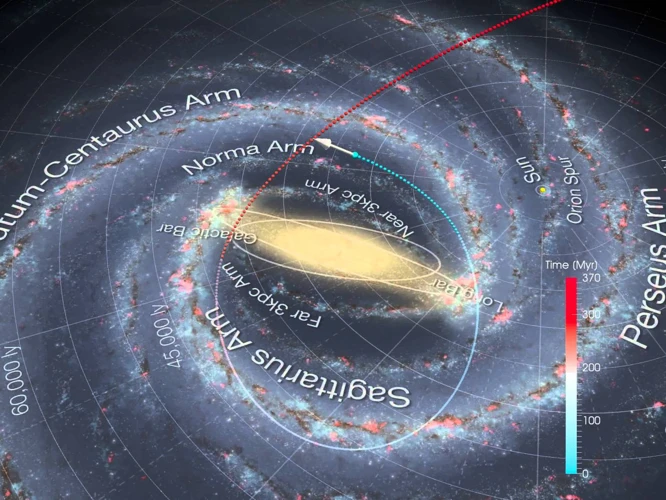
Connecting with the early universe allows us to glimpse the profound mysteries that shaped our existence. Through the study of the Cosmic Microwave Background (CMB), scientists have gained valuable insights into the conditions of the early universe. The CMB provides crucial information about the composition and distribution of matter, as well as the presence of dark matter and dark energy, which are essential components in our understanding of cosmology. By examining the CMB, researchers can uncover details about the primordial soup of particles that existed shortly after the Big Bang and gain a deeper understanding of the processes that led to the formation of galaxies, stars, and ultimately life itself. Exploring the CMB opens doors to understanding the fundamental nature of the universe and our place within it, bridging the gap between our current understanding and the ancient origins of our cosmos
1. Information about the Early Universe
Understanding the early universe is a monumental task that scientists have been tirelessly pursuing for decades. Through the study of the cosmic microwave background (CMB), we have gained invaluable insights into the conditions that existed during the early moments of our universe. According to the prevailing Big Bang theory, the universe originated from a hot, dense state approximately 13.8 billion years ago. In the first few moments after the Big Bang, the universe underwent rapid expansion, known as cosmic inflation /zodiac-signs-health/. This period of inflation caused the universe to grow exponentially, smoothing out irregularities and laying the groundwork for the formation of galaxies and other cosmic structures. By studying the CMB, scientists can analyze the patterns and fluctuations in its temperature and polarization, providing evidence of the cosmic inflation theory. These fluctuations, imprinted on the CMB, reveal the density variations in the early universe that eventually led to the formation of galaxies, stars, and planets. The CMB acts as a time capsule, preserving information about the structures and components of the universe when it was just a fraction of a second old. By deciphering the CMB’s intricate details, scientists can unlock the secrets of the early universe, painting a clearer picture of how our cosmos came into existence /significance-sextilles-astrological-aspects/. The information encoded in the CMB serves as a treasure trove for studying fundamental physics, cosmology, and the origins of the universe itself.
2. Studying Dark Matter and Dark Energy
Understanding the nature and properties of dark matter and dark energy is one of the most pressing challenges in modern cosmology. The study of the Cosmic Microwave Background (CMB) has provided valuable insights into these enigmatic cosmic phenomena.
1. Dark Matter: By examining the patterns and fluctuations in the CMB, scientists can gain valuable information about the distribution and behavior of dark matter in the early universe. Dark matter, which does not interact with light or other forms of electromagnetic radiation, is thought to make up a significant portion of the universe’s mass. Through observations of the CMB, scientists can measure the gravitational effects of dark matter on the formation and evolution of cosmic structures, such as galaxies and galaxy clusters. These measurements help refine our understanding of dark matter’s role in shaping the large-scale structure of the universe.
2. Dark Energy: The CMB also provides insights into the mysterious dark energy, which is believed to be responsible for the accelerated expansion of the universe. Dark energy remains one of the biggest puzzles in cosmology, and studying the CMB can help constrain its properties. By analyzing the CMB data, scientists can determine the geometry of the universe and measure the rate of expansion at different epochs. These measurements contribute to our understanding of the influence of dark energy in driving the universe’s expansion and shaping its fate.
3. Future Investigations: Ongoing and future experiments, such as the upcoming CMB-S4 (Cosmic Microwave Background Stage-4) project, aim to further enhance our understanding of dark matter and dark energy using the CMB. These experiments will provide higher-resolution maps of the CMB and more precise measurements of its properties. By combining these new datasets with other cosmological observations, scientists hope to unravel the mysteries of dark matter and dark energy, shedding light on the fundamental nature of our universe.
The study of the CMB has proven to be an invaluable tool in studying and understanding dark matter and dark energy. It offers a unique perspective on these elusive cosmic components, helping to unravel the secrets of the universe’s composition and its profound influence on its evolution.
Future Prospects

Looking towards the future, there are exciting prospects on the horizon for the study of the cosmic microwave background (CMB). Advances in technology and scientific techniques are enabling researchers to dive deeper into the mysteries of the CMB and unlock its full potential. One area of focus is the development of more sophisticated instruments and telescopes capable of higher resolution and sensitivity, allowing us to capture even more detailed and accurate measurements of the CMB. Additionally, upcoming missions such as the Simons Observatory and the CORE mission by the European Space Agency hold promise for groundbreaking discoveries in the field. These missions will provide invaluable data, helping us unravel the remaining puzzles surrounding the CMB and further our understanding of the early universe. With each new advancement, we edge closer to unraveling the secrets hidden within the faint whispers of the CMB and gaining insights into the fundamental nature of our universe. Exciting times lie ahead as we continue this cosmic journey towards greater knowledge and comprehension.
1. Advancements in CMB Research
1. Advancements in CMB Research:
– Improved Data Analysis Techniques: Scientists have made significant strides in refining data analysis techniques to extract detailed information from the cosmic microwave background (CMB) data. They have developed sophisticated statistical models and algorithms that enable them to better distinguish subtle variations in the CMB signal, ultimately leading to improved measurements and a deeper understanding of the early universe.
– Higher Resolution Mapping: Advancements in technology have allowed for the development of more powerful telescopes and detectors. These instruments are capable of capturing higher resolution maps of the CMB, revealing finer details of the cosmic microwave background radiation. The higher resolution maps provide valuable insights into the early structure of the universe, such as the distribution of matter and the formation of large-scale structures.
– Polarization Measurements: Scientists have started to explore the polarization of the CMB as a new frontier in research. Polarization measurements of the CMB can reveal information about the universe’s early stages, including the existence of gravitational waves and the nature of inflation. Researchers are developing new experiments and instruments, such as the Atacama Cosmology Telescope and the Simons Observatory, to detect and analyze the polarization of the CMB with unprecedented precision.
– Multi-Wavelength Observations: In addition to studying the CMB at microwave frequencies, scientists have begun conducting observations at other wavelengths to gain a comprehensive understanding of the early universe. By combining data from various wavelengths, such as infrared, X-ray, and gamma-ray, researchers can study different aspects of the CMB emission and probe specific phenomena, such as galaxy formation, active galactic nuclei, and dark matter.
– Cross-Correlation Studies: Scientists are increasingly employing cross-correlation studies to enhance our understanding of the CMB. These studies involve comparing CMB data with data from other cosmological probes, such as galaxy surveys or gravitational lensing maps. By cross-referencing and correlating different datasets, researchers can uncover valuable insights about the nature of cosmic evolution, the properties of dark matter, and the growth of structure in the universe.
The field of CMB research continues to evolve rapidly, driven by technological advancements and innovative analysis techniques. These advancements are revolutionizing our understanding of the early universe and paving the way for exciting new discoveries in cosmology. By pushing the boundaries of our knowledge and capabilities, scientists are harnessing the power of the CMB to unlock the secrets of our cosmic origins.
2. Upcoming Missions and Discoveries
Upcoming missions and discoveries in the field of cosmic microwave background (CMB) research hold tremendous potential for unraveling further secrets of the early universe. Scientists and astronomers continue to develop cutting-edge technologies and plan new missions to delve deeper into the mysteries of the CMB. One such mission is the Spectro-Photometer for the History of the Universe, Epoch of Reionization and Ices Explorer (SPHEREx) by NASA, scheduled for launch in the mid-2020s. SPHEREx aims to study the cosmic background radiation in more detail, providing crucial insights into the history of the universe, the formation of galaxies, and the origins of elements. This mission will enhance our understanding of the CMB and its role in shaping the cosmos. Another upcoming mission is the Cosmic Origins Explorer (CORE), proposed by the European Space Agency (ESA), aiming to precisely map the CMB’s polarization patterns. This mission will help scientists unravel the mysteries surrounding cosmic inflation and provide insights into the physics of the early universe. Exciting discoveries are anticipated through these missions and other future endeavors, further expanding our knowledge of the early universe and the cosmic microwave background.
Conclusion

In conclusion, the Cosmic Microwave Background (CMB) has proven to be an invaluable tool for cosmologists and astronomers in unraveling the secrets of the early universe. Through its discovery and subsequent study, scientists have gained significant insights into the birth and evolution of our cosmos. The properties of the CMB, such as its uniformity and isotropy, have confirmed the validity of the Big Bang theory and provided evidence for cosmic inflation. The detailed mapping of the CMB by missions like the COBE satellite, the WMAP mission, and the Planck satellite has allowed scientists to observe and analyze the fluctuations in temperature and density, leading to a deeper understanding of the structure and composition of the universe. Furthermore, the CMB provides a unique chance to investigate the nature of dark matter and dark energy, which constitute the majority of the universe’s content. As advancements in technology and observational techniques continue to enhance our understanding of the CMB, future prospects for this field of research are promising. Upcoming missions like the Simons Observatory and The Next Generation Cosmic Microwave Background Experiment (CMB-S4) hold the potential for further discoveries and a deeper exploration of the early universe. The study of the CMB is an ongoing endeavor that promises to unveil even more about the origins and nature of our universe, captivating both scientists and enthusiasts with its vast cosmic secrets.
Frequently Asked Questions

1. How was the Cosmic Microwave Background (CMB) discovered?
The CMB was discovered accidentally by Arno Penzias and Robert Wilson in 1965 when they detected a persistent noise in their radio telescope. They soon realized that this noise was not caused by any terrestrial source, but rather by a pervasive background radiation coming from all directions in space.
2. What are the properties of the Cosmic Microwave Background?
The CMB is nearly uniform in all directions, with a temperature of about 2.7 Kelvin (-270.45 degrees Celsius). It is also incredibly isotropic, meaning that it has the same intensity and distribution patterns in all directions. Additionally, the CMB exhibits slight temperature fluctuations, which provide valuable insights into the structure and composition of the early universe.
3. How does the Cosmic Microwave Background support the Big Bang theory?
The CMB is a major piece of evidence supporting the Big Bang theory. According to the theory, the universe was once much hotter and denser. As it expanded and cooled down, photons were able to travel freely, resulting in the formation of the CMB. The properties of the CMB, such as its isotropy and temperature fluctuations, align with the predictions made by the Big Bang theory.
4. What is the significance of mapping the Cosmic Microwave Background?
Mapping the CMB provides valuable insights into the large-scale structure and composition of the universe. By studying the patterns and fluctuations in the CMB, astronomers can better understand the distribution of matter and energy, as well as the expansion rate of the universe. These maps also help test various cosmological models and offer evidence for concepts like cosmic inflation.
5. Which satellites have been instrumental in mapping and studying the CMB?
Several satellites have played a crucial role in mapping and studying the CMB. The COBE (Cosmic Background Explorer) satellite, launched in 1989, provided the first detailed map of the CMB, confirming its isotropy. The WMAP (Wilkinson Microwave Anisotropy Probe) mission, launched in 2001, further refined our understanding by producing a higher-resolution map. The Planck satellite, launched in 2009, provided the most precise measurements of the CMB to date.
6. What is Cosmic Inflation?
Cosmic inflation is a theory that suggests the universe underwent a rapid expansion phase shortly after the Big Bang. This exponential expansion resolved many problems in cosmology and helps explain the uniformity and structure observed in the universe. It is thought to have occurred within a fraction of a second after the Big Bang, leaving behind traces in the form of temperature fluctuations in the CMB.
7. How does the Cosmic Microwave Background provide evidence for Cosmic Inflation?
The CMB exhibits small temperature fluctuations on very large scales. These fluctuations align with predictions made by the theory of cosmic inflation. The presence of these fluctuations, known as anisotropies, provides strong evidence for the idea that the universe underwent a rapid expansion phase in its early history.
8. What information does the Cosmic Microwave Background reveal about the early universe?
The CMB offers valuable information about the early universe, such as its age, composition, and overall structure. By analyzing the temperature fluctuations in the CMB, astronomers can infer the density of matter and energy in the early stages of the universe, as well as gain insights into the formation of galaxies and large-scale structures.
9. How does studying the Cosmic Microwave Background help in understanding dark matter and dark energy?
The study of the CMB plays a crucial role in understanding dark matter and dark energy. Dark matter cannot be directly observed, but its gravitational effects can be inferred from the distribution of matter seen in the CMB maps. Similarly, the precise measurements of the CMB help in studying the effects of dark energy on the expansion rate of the universe.
10. What does the future hold for Cosmic Microwave Background research?
The future of CMB research looks promising. Advancements in technology and data analysis techniques will lead to more precise measurements of the CMB, allowing for deeper insights into the nature of the early universe, inflationary models, and the mysteries of dark matter and dark energy. Upcoming missions such as the Simons Observatory and the LiteBIRD mission will provide further discoveries and advancements in our understanding of the CMB.
References
Frequently Asked Questions

1. How was the Cosmic Microwave Background (CMB) discovered?
The CMB was discovered in 1964 by radio astronomers Arno Penzias and Robert Wilson. They were using a large horn antenna and detected a faint radio signal that seemed to come from every direction in space.
2. What are the properties of the Cosmic Microwave Background?
The CMB is a form of electromagnetic radiation that permeates the entire universe. It has a near-perfect black body spectrum with a temperature of about 2.7 Kelvin. It is also extremely isotropic, meaning it appears the same in all directions.
3. What is the Big Bang Theory?
The Big Bang Theory is the prevailing explanation for the origin of the universe. It suggests that the universe began as an extremely hot and dense point, and has been expanding and cooling ever since.
4. How does the Cosmic Microwave Background relate to the Big Bang Theory?
The CMB provides strong evidence in support of the Big Bang Theory. The theory predicts that after the Big Bang, the universe was filled with hot plasma that emitted radiation. As the universe expanded and cooled, this radiation stretched and cooled, ultimately becoming the CMB we observe today.
5. How was the CMB mapped?
The CMB has been mapped by several space missions. The first was the COBE satellite, followed by the WMAP mission, and then the Planck satellite. These missions have provided increasingly detailed maps of the CMB, helping to uncover valuable information about the early universe.
6. What is cosmic inflation?
Cosmic inflation is a theory that suggests the early universe underwent a rapid and exponential expansion in the first fraction of a second after the Big Bang. It helps explain why the CMB appears so isotropic and why the universe is so homogeneous on large scales.
7. How does the CMB provide evidence for cosmic inflation?
The CMB displays small-scale temperature fluctuations known as anisotropies. These anisotropies match the predictions made by cosmic inflation, providing strong evidence for the theory. They reveal details about the seeds of large-scale structures like galaxies and clusters of galaxies.
8. What information does the CMB provide about the early universe?
The CMB allows us to study the conditions of the universe when it was just 380,000 years old. By analyzing its properties, we can learn about the composition, density, and temperature of the early plasma, as well as the processes that shaped the structure of the universe.
9. How does the CMB help in studying dark matter and dark energy?
The CMB provides valuable clues about the distribution of matter in the early universe. By studying how matter and energy interacted in the early stages, scientists can better understand the role of dark matter and dark energy in the evolution of the universe.
10. What are the future prospects in CMB research?
Advancements in technology and upcoming space missions, like the upcoming James Webb Space Telescope, promise to provide even more detailed data about the CMB. This will allow scientists to further refine our understanding of the early universe and its fundamental properties.

